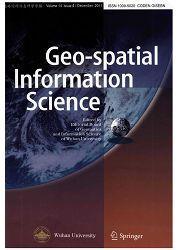基于HFA-Net的质量分级的大范围全覆盖图像生成的时空图像选择
IF 5.5
1区 地球科学
Q1 REMOTE SENSING
引用次数: 0
摘要
在许多应用中,遥感图像往往需要合并成更大的拼接图像,以支持对大面积的分析。但是,如果有许多区域被云覆盖,或者用于合并的图像跨度较长,则拼接图像的性能可能会受到严重限制。因此,本文提出了一种生成全覆盖图像(即无云污染像素的拼接图像)的图像选择方法。具体而言,提出了一种基于swing - transformer的区域质量分级高频感知网络,为图像选择提供数据依据。提出了时空约束来优化图像选择。在时间维度上,最短时间跨度约束缩短了所选图像的时间跨度,明显提高了图像选择结果的时效性(即更短的时间跨度)。在空间维度上,提出空间连续性约束,选择质量更好、面积更大的数据,提高结果的辐射连续性。在GF-1图像上的实验表明,与改进的面向覆盖的检索算法(MICR)和基于网格补偿的检索方法(RMGC)相比,该方法在最短时间跨度上分别降低了76.1%和38.7%的平均值。此外,与MICR、RMGC和基于像素的时间序列合成方法(ptm)相比,该方法平均减少了91.2%、89.8%和83.4%的剩余云量。本文章由计算机程序翻译,如有差异,请以英文原文为准。
Spatiotemporal imagery selection for full coverage image generation over a large area with HFA-Net based quality grading
Remote sensing images often need to be merged into a larger mosaic image to support analysis on large areas in many applications. However, the performance of the mosaic imagery may be severely restricted if there are many areas with cloud coverage or if these images used for merging have a long-time span. Therefore, this paper proposes a method of image selection for full coverage image (i.e. a mosaic image with no cloud-contaminated pixels) generation. Specifically, a novel High-Frequency-Aware (HFA)-Net based on Swin-Transformer for region quality grading is presented to provide a data basis for image selection. Spatiotemporal constraints are presented to optimize the image selection. In the temporal dimension, the shortest-time-span constraint shortens the time span of the selected images, obviously improving the timeliness of the image selection results (i.e. with a shorter time span). In the spatial dimension, a spatial continuity constraint is proposed to select data with better quality and larger area, thus improving the radiometric continuity of the results. Experiments on the GF-1 images indicate that the proposed method reduces the averages by 76.1% and 38.7% in terms of the shortest time span compared to the Improved Coverage-oriented Retrieval algorithm (MICR) and Retrieval Method based on Grid Compensation (RMGC) methods, respectively. Moreover, the proposed method also reduces the residual cloud amount by an average of 91.2%, 89.8%, and 83.4% when compared to the MICR, RMGC, and Pixel-based Time-series Synthesis Method (PTSM) methods, respectively.
求助全文
通过发布文献求助,成功后即可免费获取论文全文。
去求助
来源期刊

Geo-spatial Information Science
REMOTE SENSING-
CiteScore
10.10
自引率
28.30%
发文量
710
审稿时长
31 weeks
期刊介绍:
Geo-spatial Information Science was founded in 1998 by Wuhan University, and is now published in partnership with Taylor & Francis. The journal publishes high quality research on the application and development of surveying and mapping technology, including photogrammetry, remote sensing, geographical information systems, cartography, engineering surveying, GPS, geodesy, geomatics, geophysics, and other related fields. The journal particularly encourages papers on innovative applications and theories in the fields above, or of an interdisciplinary nature. In addition to serving as a source reference and archive of advancements in these disciplines, Geo-spatial Information Science aims to provide a platform for communication between researchers and professionals concerned with the topics above. The editorial committee of the journal consists of 21 professors and research scientists from different regions and countries, such as America, Germany, Switzerland, Austria, Hong Kong and China.
 求助内容:
求助内容: 应助结果提醒方式:
应助结果提醒方式:


